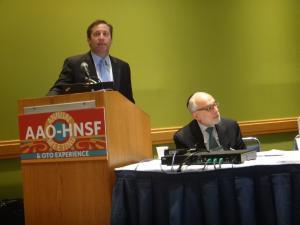Earlier this month, the American Academy of Otolaryngology–Head and Neck Surgery held their 2017 Annual Meeting (AAO-HNS 2017) in Chicago. Sleep surgery again was featured prominently in the program. Aside from the International Surgical Sleep Society conferences, the AAO-HNS meetings have the largest number of sessions related to sleep surgery. My own schedule was fairly busy with giving presentations, including instruction courses on drug-induced sleep endoscopy and Tongue Region surgery and expert panels on sleep surgery and non-surgical treatments.
Scientific meetings are enjoyable when they are both “scientific” and “meetings”. To explain what I mean, first the “meetings” part of the equation. Over the years, I have been fortunate enough to count numerous leaders in sleep surgery from the US and around the world as colleagues and friends. At AAO-HNS 2017, it was wonderful to connect with them and share experiences to learn from each other. As for the “scientific”, it has been exciting to see an expanding number of research presentations related to sleep surgery. This year, the majority of research presentations at AAO-HNS 2017 were related to drug-induced sleep endoscopy and Inspire Medical Systems’ Upper Airway Stimulation.
What is Positional Obstructive Sleep Apnea, and Why Does It Occur?
Over half of all patients with obstructive sleep apnea have what is called positional obstructive sleep apnea, meaning that their sleep apnea is at least twice as severe when sleeping on their back vs. on their side or stomach. If sleeping on their side or stomach eliminates the sleep apnea, then that may be a treatment option by itself. In many cases, the sleep apnea will get better when someone sleeps on their side but will not clear up entirely. In other cases, someone may not be able to sleep on their side for any one of a number of reasons, such as pain that develops when their weight rests on their shoulder. There are some new treatments available for positional sleep apnea, although the most interesting treatment (Night Balance) is not yet available in the United States.
The reasons for positional sleep apnea are not well-understood, and there are very few studies that have explored why it occurs in some patients but not others. Dr. Ronica Patel, one of our residents in our USC Caruso Department of Otolaryngology–Head & Neck Surgery, presented her work with my patients undergoing drug-induced sleep endoscopy while on their side and then rolled onto their back. She showed that the structures around the throat are affected by gravity; the soft palate and tongue will fall backwards more when someone is on their back, while the sides of the throat will collapse more when someone is sleeping on their side. This was not unexpected. However, what was most interesting was that there was overall less collapse of the sides of the throat in those with positional sleep apnea, compared to those whose sleep apnea did not vary according to body position.
Dr. Katherine Green from the University of Colorado, a former USC Sleep Medicine fellow, presented work from our drug-induced sleep endoscopy study of 14 leading sleep surgery centers from around the world. The purpose of the study is to examine whether findings of preoperative drug-induced sleep endoscopy are associated with sleep surgery outcomes. The final findings are awaiting some additional data clarification, and I promise that these results will be the subject of a dedicated blog post because they are of interest to all of us who are using drug-induced sleep endoscopy in treating patients with sleep apnea.
AAO-HNS 2017 Updates on Upper Airway Stimulation
There were multiple presentations related to Upper Airway Stimulation, ranging from more-detailed studies of the surgical technique to examination of results in busy centers. At USC, we have been part of the ADHERE Registry Study that is supported by Inspire Medical Systems but designed to evaluate the results in patients who receive this treatment outside the strict confines of an FDA-approved study. (Note: we receive research grant funding for being part of this study and for the post-FDA-approval study that is also funded by Inspire Medical Systems.)
Dr. Maurits Boon from Thomas Jefferson University in Philadelphia presented the results of the almost 300 patients in the ADHERE Registry Study. The short answer is that the results are very similar to those reported in the FDA-approved STAR Trial that now has results extending to 5 years after implantation: 2 out of 3 patients experience marked improvement in sleep apnea (measured by sleep studies and by questionnaires for sleepiness and sleep-related quality of life), with even more patients using the therapy every night or almost every night. These results were no surprise to those of us who treat patients with Upper Airway Stimulation, and we hope that they strengthen the argument for using this approach in appropriate candidates.
A Different Twist on “Inspire”
I am often contacted by various groups looking to write articles or other features on me in exchange for payments or some other sort of marketing/promotional arrangement, whether a guest blog or something similar. My simple rule is that I do not do this. Recently, Voyage LA Magazine approached me as one of LA’s “most inspiring stories” (their words, not mine). I do not think my story in an inspiring one, as any progress to which I have contributed is at least 99% perspiration, to paraphrase the words of Thomas Edison. However, I certainly try to inspire others around me. Voyage LA Magazine wrote a short article about me that you might find amusing. More importantly, I encourage anyone with a few minutes to spare to read some of the other stories on their site that are truly inspiring.




− 3 = 1